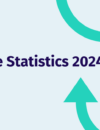
For the first time ever, primetime Saturday night television is propelling the conversation forward on how deaf and hard of hearing people can move through an often unaccommodating world.
Rose Ayling-Ellis (who uses British Sign Language) is the first deaf contestant in the history of Strictly Come Dancing, since its launch on the BBC in 2004.
Best known for playing Frankie Lewis, EastEnders’ first deaf character, Rose shared that being “the first deaf contestant on Strictly Come Dancing is sooooo exciting… and a little bit scary. I hope I will do the deaf community proud and break down more barriers.”
Rose’s performances so far with her dance partner Giovanni Pernice have incorporated many heartfelt moments to recognise the deaf community, including introducing British Sign Language choreography to a Viennese Waltz and using a silent moment with no music during a couple’s choice routine.
Both performances received an outpouring of positive support across social media, as well as 9s and 10s from the judges. Further to that, analysis of Google search data showed that UK searches for the phrase “sign language” increased by a whopping 488% following the performances.
Supporting deaf and hard of hearing people in the workplace
With Rose raising awareness in the mainstream, let’s look at how employers too can better support deaf and hard of hearing people in the workplace.
A recent survey by Action on Hearing Loss found that, after making employers aware of their disability, 43% of deaf and hard of hearing people found that adequate measures were not implemented to help them carry out their job. 79% of people reported experiencing stress as a result.
A separate study by Total Jobs found that 25% of deaf and hard of hearing people have left a place of work because they felt discriminated against. Although 74% believed they possessed the skills necessary to fulfil their job role, over 50% received unfair treatment from management and colleagues whilst in their roles.
Clearly employers need to be doing better.
1. Consider individual needs and avoid misconceptions
There’s a common assumption that being deaf or hard of hearing means the individual can’t hear anything at all. But each individual you work with is exactly that: an individual. Treat all employees in the way that works best for them and research and understand what they specifically need and would like in the workplace. For example, whilst many people online have mused over how Rose can dance without hearing any music, Rose herself says: “It is a common misconception that deaf people can’t enjoy music. I have a hearing aid, so I pick up some of the music and I can hear the beat. I can hear someone singing, but I can’t identify exact words. I also feel the vibrations.”
2. Do your research and make reasonable adjustments as outlined by law
It’s a requirement by law that employers make reasonable adjustments “to make sure workers with disabilities, or physical or mental health conditions, aren’t substantially disadvantaged when doing their jobs.” Failure to comply with making reasonable adjustments is classed as discrimination and would be in breach of the Equality Act 2010. Reasonable adjustments apply to both the recruitment process (making sure the deaf or hard of hearing person is able to fully take part in all application stages) and once the employee is part of the team (making sure they can fully carry out their role with no undue difficulty).
The Access to Work scheme in the UK can help employers by providing a grant to cover the costs of hiring a BSL interpreter or a note-taker, paying for video relay services or providing deaf awareness training to the rest of your workforce.
Other reasonable adjustments might need to be made to your office. An open plan office, for example, can be difficult for those who wear hearing aids which pick up a lot of background noise. Consider your health and safety procedures too and whether you have a visual warning system in place for emergencies. Most fire alarms work on a sound system alone, as opposed to an audio-visual system where you’d implement a flashing light signal and text system to alert hard of hearing colleagues in an emergency.
3. Consider your visual communication in meetings and interviews
Deaf and hard of hearing people can rely heavily on lip-reading, facial recognition and hand gestures during conversation. Make sure your body language is clear during group discussions: don’t face away from your deaf colleague; ensure you make good eye contact and don’t cover your mouth; have good lighting in your meeting rooms, and offer a visual cue when you begin speaking.
Following up all of your meetings with notes via email or Slack will help to make sure nothing gets missed or misinterpreted.
4. Provide mandatory training to other members of the team
Being deaf or hard of hearing in the workplace can be an isolating experience if other hearing members of the team aren’t aware of the considerations they need to make. In fact, the study conducted by Total Jobs found that “lack of deaf awareness” and “feeling isolated or left out” were both top challenges encountered by deaf people at work.
By running company-wide deaf awareness training, your team will feel better equipped to communicate with their deaf or hard of hearing colleagues. Many team members might not have interacted with a deaf or hard of hearing person before, so knowing the right things to do will not only boost the team’s confidence, it will critically mitigate against feelings of isolation and improper treatment for your deaf or hard of hearing colleagues.
At Druthers, it’s our mission and our passion to empower organisations to find the best person to make an impact on their work, from a diverse shortlist of remarkable talent. Get in touch with us to find out how your business can make a positive change to your hiring and retention processes.





